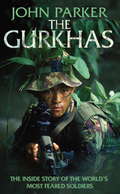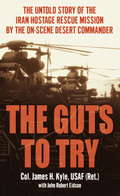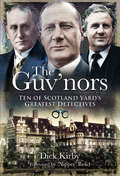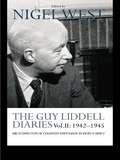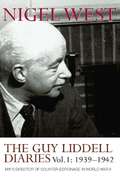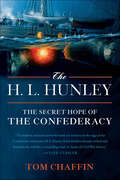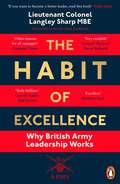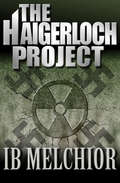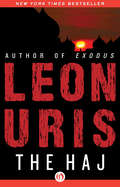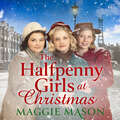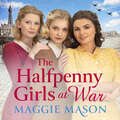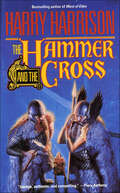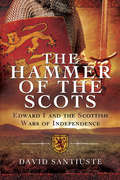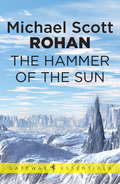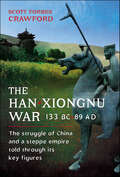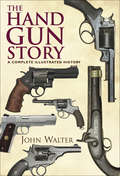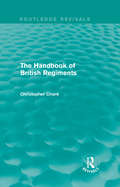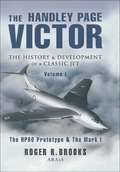- Table View
- List View
The Gurkhas: An updated in-depth investigation into the history and mystique of the Gurkha regiments
by John ParkerTheir ferocity is as legendary as their loyalty to the British Monarch and their regimental histories are crammed with acts of incredible bravery and sacrifice. Their reputation as fearsome fighting men remains undisputed and the mere threat of their kukri knives has put the fear of God into opposing forces throughout the world. John Parker's book is a fascinating testimony to the Gurkhas - a fighting force that stands dramatically apart in British military history.
The Gurkhas: An updated in-depth investigation into the history and mystique of the Gurkha regiments
by John ParkerTheir ferocity is as legendary as their loyalty to the British Monarch and their regimental histories are crammed with acts of incredible bravery and sacrifice. Their reputation as fearsome fighting men remains undisputed and the mere threat of their kukri knives has put the fear of God into opposing forces throughout the world. John Parker's book is a fascinating testimony to the Gurkhas - a fighting force that stands dramatically apart in British military history.
The Guts to Try: The True Story of the Iran Hostage Rescue Mission By the On-Scene Desert Commander
by John Robert Eidson James H. KyleFrom one of the highest ranking officers on the ground in Iran comes a no-holds-barred look at America's brave mission against terrorism. Colonel James H. Kyle was involved in every stage of the Iran hostage rescue operation. As Desert-1 Commander, he alone bore responsibility for the courageous mission. Now Colonel Kyle spares no one, including himself, in this riveting account that takes readers from the initial brainstorming sessions and training camps to the desert rehearsals, the forward staging areas in Egypt and Oman, and finally to the desert refueling site, where he decided to abort. Colonel Kyle provides honest answers to tough questions: Why were the pilots caught totally off guard by the weather? How did the CIA contribute to the mission's breakdown? And could such a failure happen again? The Guts to Try is a thrilling true-life adventure story-exploring America's ability to react quickly, forcefully, and effectively to acts of terrorism.
The Guv’nors: Ten of Scotland Yard’s Greatest Detectives
by Dick KirbyThe ten Scotland Yard detectives, featured in The Guvnors, are unique. Such a group of intrepid crime-busters will never exist again. They possessed only the most rudimentary education; none had a degree. Intuition and knowledge of their manor counted for more than DNA and databases. They worked tirelessly in the pursuit of criminals, used informants, worked on hunches and grabbed hold of investigations and shook them until every piece of evidence was unearthed. Criminals trembled when these detectives were after them because, once they were nicked, they stayed nicked.The Guvnors covers legends such as Fred Wensley, who nailed strips of bicycle tyres to the soles of his boots when on the look-out for Jack the Ripper. He later formed the Flying Squad and became chief constable of the CID. Fred Sharpe would single-handedly confront forty of the worst racetrack gangsters and tell them to clear off, anyone who refused would collect a punch on the jaw. Sharpe later became head of the Flying Squad, as did Bob Fabian, who was awarded the Kings Police Medal for dismantling an IRA bomb.Bert Wickstead, known as The Gangbuster, literally terrorised the gangs who attempted to fill the void in Londons East End, after the demise of the Kray bothers.This is a book which will delight those who want to know what life was like when The Guvnors and others like them were in charge of law and order and the streets were far safer than they are today.
The Guy Liddell Diaries Vol.II: MI5's Director of Counter-Espionage in World War II
by Nigel WestWALLFLOWERS is the codename given to one of the Security Service’s most treasured possessions, the daily journal dictated from August 1939 to June 1945 by MI5’s Director of Counter-Espionage, Guy Liddell, to his secretary, Margo Huggins. The document was considered so highly classified that it was retained in the safe of successive Directors-General, and special permission was required to read it. Liddell was one of three brothers who all won the Military Cross during the First World War and subsequently joined MI5. He initially first served in the Metropolitan Police Special Branch at Scotland Yard, dealing primarily with cases of Soviet espionage, until he was transferred to MI5 in 1931. His social connections proved important because in 1940 he employed Anthony Blunt as his personal assistant and became a close friend of both Guy Burgess and Victor Rothschild, and was acquainted with Kim Philby. Despite these links, when Liddell retired from the Security Service in 1952 he was appointed security adviser to the Atomic Energy Commission, an extremely sensitive post following the conviction of the physicist Klaus Fuchs two years earlier. No other member of the Security Service is known to have maintained a diary and the twelve volumes of this journal represents a unique record of the events and personalities of the period, a veritable tour d’horizon of the entire subject. As Director, B Division, Liddell supervised all the major pre-war and wartime espionage investigations, maintained a watch on suspected pro-Nazis and laid the foundations of the famous ‘double cross system’ of enemy double agents. He was unquestionably one of the most reclusive and remarkable men of his generation, and a legend within his own organisation.
The Guy Liddell Diaries, Volume I: MI5's Director of Counter-Espionage in World War II
by Nigel WestThis is the first volume of Nigel West's acclaimed presentation of these fascinating diaries from the heart of Britain's Second World War intelligence operations. 'No intelligence buff can be without this volume and anyone interested in British twentieth century history needs it too.' M.R.D. Foot, The Spectator 'Regarded by historians as the most important military intelligence documents from the whole of the Second World War.' Irish Independent '[A] unique insight into the espionage secrets of the Second World War. Its historical importance is enhanced by the editing of Nigel West who, apart from decoding several obscure references to the secret war, persuaded the Security Service to break their rule of maintaining an agent's anonymity.' BBC History Magazine WALLFLOWERS is the codename given to one of the Security Service's most treasured possessions, the daily journal dictated from August 1939 to June 1945 by MI5's Director of Counter Espionage, Guy Liddell, to his secretary, Margo Huggins. The document was considered so highly classified that it was retained in the safe of successive Directors General, and special permission was required to read it.No other member of the Security Service is known to have maintained a diary and the twelve volumes of this journal represent a unique record of the events and personalities of the period, a veritable tour d'horizon of the entire subject. As Director, B Division, Liddell supervised all the major pre-war and wartime espionage investigations, maintained a watch on suspected pro-Nazis and laid the foundations of the famous 'double cross system' of enemy double agents. He was unquestionably one of the most reclusive and remarkable men of his generation, and a legend within his own organization.
The H. L. Hunley: The Secret Hope of the Confederacy
by Tom ChaffinA major reconsideration of the role of the American West in the causes, military conduct, and consequences of the Civil War. On the evening of February 17, 1864, the Confederacy's H. L. Hunley sank the Union's formidable sloop of war the USS Housatonic and became the first submarine in world history to sink an enemy ship. But after accomplishing such a feat, the Hunley and her crew of eight also vanished beneath the cold Atlantic waters off Charleston, South Carolina. For generations, the legend of the Hunley grew as searchers prowled the harbor, looking for remains. Even after the submarine was definitively located in 1995 and recovered five years later, those legends have continued to flourish. In a tour de force of document-sleuthing and insights gleaned from the excavation of this remarkable vessel, the distinguished Civil War–era historian Tom Chaffin presents the most thorough telling of the Hunley's story possible. Of panoramic breadth, this saga begins long before the submarine was even assembled and follows the tale into the boat's final hours and through its recovery in 2000. Engaging and groundbreaking, The H. L. Hunley provides the definitive account of a fabled craft.
The Habit of Excellence: Why British Army Leadership Works
by Lt Col Langley SharpThe official British Army book on what makes its leadership so successful, and how to become a better leader yourself - whatever your field. ___________________'If you want to become a better leader, read this book' Eddie Jones'An extraordinary read for any leader. Truly brilliant' General Stanley McChrystal, author of Team of Teams'Excellent. Offers proven tools and strategies' Matthew Syed___________________ The Habit of Excellence is a unique insight into British Army leadership, explaining what makes it unique, what makes it so effective and what civilians can take from it to become better leaders themselves. Drawing on the latest research in military history, business, sociology, psychology and behavioural science, and with compelling illustration from British Army operations across the centuries, Lt Col Langley Sharp MBE goes beyond the latest leadership fads to distil into one peerlessly authoritative work the essence of leading and leadership from one of the world's most revered institutions.___________________'Excellent. It's hard to see how any leader, whatever their field, wouldn't benefit from reading and rereading it' New Statesman 'Offers lessons for all managers' Financial Times 'Valuable in any walk of life' General Sir Mike Jackson, former Chief of the General Staff 'Very readable. I could not recommend this exceptional book more' General The Lord David Richards, former Chief of the Defence Staff 'Comprehensive and clearly written' Karin von Hippel, Director-General of RUSI 'Terrific. Full of insights and lessons' General David Petraeus, former Director of the CIA
The Haigerloch Project
by Ib MelchiorIt was World War II&’s master weapon, and Hitler had it first. As Germany crumbled, Hitler feverishly raged against final defeat. Every qualified citizen in the Reich was committed to developing an atomic bomb. In 1945, they almost succeeded. The code name was the Haigerloch Project. The shock-a-second thriller of a brilliant scientist and a deadly spy threat to the most crucial Allied mission of the war, The Haigerloch Project is a heart-pounding race against time that explodes with more page-searing excitement than The Eagle Has Landed.
The Haj
by Leon UrisA proud Arab family in Palestine struggles to hold on to its identity during the birth of the State of Israel In the early 1920s, young Ibrahim al Soukori has achieved his dreams of heading his small Palestinian town, becoming a proud father, and making the pilgrimage to Mecca. But his family's journey has just begun, and soon global war and Israel's formation force them on a path to possible dissolution. Ibrahim's sons and daughters squabble and find peace with the nearby kibbutz, suffer betrayals, and hold together even when displaced to distant refugee camps. Written by an author best known for his sympathetic portrayal of Israel's difficult birth, The Haj speaks to the history of a troubled region from the perspective of a remarkable Arab dynasty. This ebook features an illustrated biography of Leon Uris including rare photos from the author's estate.
The Halfpenny Girls at Christmas: A heart-warming and nostalgic festive family saga - the perfect winter read!
by Maggie MasonTHE SECOND NOVEL IN THE BRAND NEW SAGA SERIES BY MAGGIE MASON - MEET THE HALFPENNY GIRLS. . . 'In the grand tradition of sagas set down by the late and great Catherine Cookson ' Jean Fullerton on Blackpool LassWill their prayers be answered at the most wonderful time of the year?/font>As Christmas approaches, Alice, Edith and Marg continue to face hardships growing up on one of the poorest streets in Blackpool. Penniless, their friendship has helped them survive this far, but it'll take more than that to see them through the dark days that lie ahead . . .Newly married Alice receives shocking news about her pregnancy that threatens the future she's always dreamed of, Marg is struggling to care for her ailing mother and ensure her little sister receives the education she deserves, and Edith is grieving the loss of her family while preparing to marry her sweetheart. The Halfpenny Girls once again are faced with a struggle, but with the festive season upon them will family, friendship and Christmas spirit see them through?The second in a brand new series from reader favourite Maggie Mason, The Halfpenny Girls is the perfect heart-warming family saga about overcoming hardship and the value of friendship. Perfect for fans of Val Wood, Kitty Neale and Rosie Goodwin.Readers LOVE Maggie Mason's Blackpool sagas:'5 stars - I wish I could give it more. Wonderful read.''Another must read book''What a brilliant book. I couldn't put it down!''I was hooked from the first page . . . this author is a must read''A totally absorbing read'
The Halfpenny Girls at Christmas: A heart-warming and nostalgic festive family saga - the perfect winter read!
by Maggie MasonTHE SECOND NOVEL IN THE BRAND NEW SAGA SERIES BY MAGGIE MASON - MEET THE HALFPENNY GIRLS. . . 'In the grand tradition of sagas set down by the late and great Catherine Cookson ' Jean Fullerton on Blackpool LassWill their prayers be answered at the most wonderful time of the year?/font>As Christmas approaches, Alice, Edith and Marg continue to face hardships growing up on one of the poorest streets in Blackpool. Penniless, their friendship has helped them survive this far, but it'll take more than that to see them through the dark days that lie ahead . . .Newly married Alice receives shocking news about her pregnancy that threatens the future she's always dreamed of, Marg is struggling to care for her ailing mother and ensure her little sister receives the education she deserves, and Edith is grieving the loss of her family while preparing to marry her sweetheart. The Halfpenny Girls once again are faced with a struggle, but with the festive season upon them will family, friendship and Christmas spirit see them through?The second in a brand new series from reader favourite Maggie Mason, The Halfpenny Girls is the perfect heart-warming family saga about overcoming hardship and the value of friendship. Perfect for fans of Val Wood, Kitty Neale and Rosie Goodwin.Readers LOVE Maggie Mason's Blackpool sagas:'5 stars - I wish I could give it more. Wonderful read.''Another must read book''What a brilliant book. I couldn't put it down!''I was hooked from the first page . . . this author is a must read''A totally absorbing read'
The Halfpenny Girls at Christmas: A heart-warming and nostalgic festive family saga - the perfect winter read!
by Maggie MasonTHE SECOND NOVEL IN THE BRAND NEW SAGA SERIES BY MAGGIE MASON - MEET THE HALFPENNY GIRLS. . . 'In the grand tradition of sagas set down by the late and great Catherine Cookson ' Jean Fullerton on Blackpool LassWill their prayers be answered at the most wonderful time of the year?/font>As Christmas approaches, Alice, Edith and Marg continue to face hardships growing up on one of the poorest streets in Blackpool. Penniless, their friendship has helped them survive this far, but it'll take more than that to see them through the dark days that lie ahead . . .Newly married Alice receives shocking news about her pregnancy that threatens the future she's always dreamed of, Marg is struggling to care for her ailing mother and ensure her little sister receives the education she deserves, and Edith is grieving the loss of her family while preparing to marry her sweetheart. The Halfpenny Girls once again are faced with a struggle, but with the festive season upon them will family, friendship and Christmas spirit see them through?The second in a brand new series from reader favourite Maggie Mason, The Halfpenny Girls is the perfect heart-warming family saga about overcoming hardship and the value of friendship. Perfect for fans of Val Wood, Kitty Neale and Rosie Goodwin.Readers LOVE Maggie Mason's Blackpool sagas:'5 stars - I wish I could give it more. Wonderful read.''Another must read book''What a brilliant book. I couldn't put it down!''I was hooked from the first page . . . this author is a must read''A totally absorbing read'
The Halfpenny Girls at War: the BRAND NEW heart-warming and nostalgic family saga
by Maggie MasonTHE THIRD NOVEL IN THE BRAND NEW SAGA SERIES BY MAGGIE MASON - MEET THE HALFPENNY GIRLS. . . 'In the grand tradition of sagas set down by the late and great Catherine Cookson ' Jean Fullerton on Blackpool LassWill friendship see them through the struggles of war?As war approaches, Alice, Edith and Marg fear for the safety of their families, while trying to decide the best way they can do their bit for their country.Alice decides to volunteer with the Red Cross, helping those most in need, Marg is preparing to marry her true love at the most dangerous of times, and Edith hopes to finally realise her dream of becoming a teacher, and starting a family of her own.Things have never been easy for The Halfpenny Girls, but family, friendship and community spirit will always see them through the darkest of days. . . The third in a brand new series from reader favourite Maggie Mason, The Halfpenny Girls at War is the perfect heart-warming family saga about overcoming hardship and the value of friendship. Perfect for fans of Val Wood, Kitty Neale and Rosie Goodwin'In the grand tradition of sagas set down by the late and great Catherine Cookson' Jean Fullerton on Blackpool LassReaders LOVE Maggie Mason's Blackpool sagas:'5 stars - I wish I could give it more. Wonderful read.''Another must read book''What a brilliant book. I couldn't put it down!''I was hooked from the first page . . . this author is a must read''A totally absorbing read'
The Halfpenny Girls at War: the BRAND NEW heart-warming and nostalgic family saga
by Maggie MasonTHE THIRD NOVEL IN THE BRAND NEW SAGA SERIES BY MAGGIE MASON - MEET THE HALFPENNY GIRLS. . . 'In the grand tradition of sagas set down by the late and great Catherine Cookson ' Jean Fullerton on Blackpool LassWill friendship see them through the struggles of war?As war approaches, Alice, Edith and Marg fear for the safety of their families, while trying to decide the best way they can do their bit for their country.Alice decides to volunteer with the Red Cross, helping those most in need, Marg is preparing to marry her true love at the most dangerous of times, and Edith hopes to finally realise her dream of becoming a teacher, and starting a family of her own.Things have never been easy for The Halfpenny Girls, but family, friendship and community spirit will always see them through the darkest of days. . . The third in a brand new series from reader favourite Maggie Mason, The Halfpenny Girls at War is the perfect heart-warming family saga about overcoming hardship and the value of friendship. Perfect for fans of Val Wood, Kitty Neale and Rosie Goodwin'In the grand tradition of sagas set down by the late and great Catherine Cookson' Jean Fullerton on Blackpool LassReaders LOVE Maggie Mason's Blackpool sagas:'5 stars - I wish I could give it more. Wonderful read.''Another must read book''What a brilliant book. I couldn't put it down!''I was hooked from the first page . . . this author is a must read''A totally absorbing read'
The Halfpenny Girls at War: the BRAND NEW heart-warming and nostalgic family saga
by Maggie MasonTHE THIRD NOVEL IN THE BRAND NEW SAGA SERIES BY MAGGIE MASON - MEET THE HALFPENNY GIRLS. . . 'In the grand tradition of sagas set down by the late and great Catherine Cookson ' Jean Fullerton on Blackpool LassWill friendship see them through the struggles of war?As war approaches, Alice, Edith and Marg fear for the safety of their families, while trying to decide the best way they can do their bit for their country.Alice decides to volunteer with the Red Cross, helping those most in need, Marg is preparing to marry her true love at the most dangerous of times, and Edith hopes to finally realise her dream of becoming a teacher, and starting a family of her own.Things have never been easy for The Halfpenny Girls, but family, friendship and community spirit will always see them through the darkest of days. . . The third in a brand new series from reader favourite Maggie Mason, The Halfpenny Girls at War is the perfect heart-warming family saga about overcoming hardship and the value of friendship. Perfect for fans of Val Wood, Kitty Neale and Rosie Goodwin'In the grand tradition of sagas set down by the late and great Catherine Cookson' Jean Fullerton on Blackpool LassReaders LOVE Maggie Mason's Blackpool sagas:'5 stars - I wish I could give it more. Wonderful read.''Another must read book''What a brilliant book. I couldn't put it down!''I was hooked from the first page . . . this author is a must read''A totally absorbing read'
The Hammer
by K. J. ParkerGignomai is the youngest brother in the current generation of met'Oc, a once-noble family exiled on an island for their role in a vaguely remembered civil war. On this island, a colony was founded seventy years ago. The plan was originally for the colonists to mine silver, but there turned out not to be any. Now, an uneasy peace exists on the island, between the colonists and the met'Oc. The met'Oc are tolerated, in spite of occasional cattle stealing raids, since they alone possess the weapons considered necessary protection against the island's savages. Gignomai is about to discover exactly what it is expected of him, and what it means to defy his family. He is the hammer who will provide the spark that will ignite a brutal and bloody war.
The Hammer and the Cross (The Hammer and the Cross #1)
by Harry HarrisonIn this rich and exciting alternate history, a Science Fiction Hall of Famer “evokes the spirit and atmosphere of the so-called Dark Ages” (Publishers Weekly).865 A.D. Warring kings rule over the British Isles, but the Church rules over the kings, threatening all who oppose them with damnation. Only the dreaded Vikings of Scandinavia do not fear the priests.Shef, the bastard son of a Norse raider and a captive English lady, is torn by divided loyalties and driven by strange visions that seem to come from Odin himself. A blacksmith and warrior, he alone dares to imagine new weapons and tactics with which to carve out a kingdom—and launch an all-out war between. . . . The Hammer and the Cross.“Savage, inventive, compelling.” —Piers Anthony, New York Times–bestselling author of the Xanth series“Few historicals are as powerfully evocative of time and place as Harrison’s tremendous saga.” —Kirkus Reviews
The Hammer of the Scots: Edward I and the Scottish Wars of Independence
by David SantiusteKnown to posterity as Scottorum Malleus - the Hammer of the Scots - Edward I was one of medieval England's most formidable rulers. In this meticulously researched new history, David Santiuste offers a fresh interpretation of Edward's military career, with a particular focus on his Scottish wars. This is in part a study of personality: Edward was a remarkable man. His struggles with tenacious opponents - including Robert the Bruce and William Wallace - have become the stuff of legend.There is a clear and perceptive account of important military events, notably the Battle of Falkirk, but the narrative also encompasses the wider impact of Edward's campaigns. He attempted to mobilize resources - including men, money and supplies - on an unprecedented scale. His wars affected people at all levels of society, throughout the British Isles.David Santiuste builds up a vivid and convincing description of Edward's campaigns in Scotland, whilst also exploring the political background. Edward emerges as a man of great conviction, who sought to bend Scotland to his will, yet also, on occasion, as a surprisingly beleaguered figure. He is presented here as the central character in a turbulent world, as commander and king.
The Hammer of the Sun (Gateway Essentials #312)
by Michael Scott RohanIn the great battle which had returned control of Morvannec, the legendary city, to mankind, Elof the Smith had saved Kara, his love, from the immortal Power which ruled her. But in the seven years since, the Smith has grown fearful that Kara, herself no mortal, will one day leave him. In his fear, Elof makes the mistake of drawing on his own uncanny powers to bind Kara closer to him; he only succeeds in driving her away. Haunted, guilt-ridden, Elof can do nothing but follow his love eastwards, across the Seas of Sunrise, towards the city of Kerys in which Kermorvan of Kerbryhaine's people had originated. In the myth-filled lands of the East, where the Powers of the Ice contemplate the total extinction of life, Elof must face his past, his future and his destiny.
The Han-Xiongnu War, 133 BC–89 AD: The Struggle of China and a Steppe Empire Told Through Its Key Figures
by Scott CrawfordThrough a series of novelistic biographies that showcase the pivotal roles and actions of those involved, dive into a centuries-long fight for survival for the Han empire that resulted in a golden age for China. The Han-Xiongnu War (133 BC – AD 89) pitted the Han dynasty of China against a confederation of nomadic steppe peoples, the Xiongnu Empire. In campaigns waged on a huge scale by the standards of contemporary Western warfare (perhaps half a million soldiers were fielded at the Battle of Mobei in 119 BC), the two states fought for control of Central Asia, hungry for its rich resources and Western trade links. China’s victory set the stage for millennia of imperial rule and a vast sphere of influence in Asia. Scott Forbes Crawford examines the war in a lively, engaging narrative. He builds a mosaic encompassing the centuries of conflict through biographies of fifteen historical figures: the Chinese and Xiongnu emperors who first led their armies into battle; ‘peace bride’ Princess Jieyou, whose marriage to a steppe king forged a vital Chinese alliance; the explorer-diplomat Zhang Qian, who almost-inadvertently established the Silk Road, among other key individuals. Their stories capture the war’s breadth, the enduring impact on Han society and statecraft in what became a Chinese golden age, and the doomed resistance of the Xiongnu to an ever-strengthening juggernaut.
The Hand Grenade
by Gordon L. RottmanThe Hand Grenade is the dramatic story, covering its origins, development, use - in the World Wars and into the present day - and lasting influence on close-quarter combat and infantry tactics.Allowing the user to inflict damage on his opponent within throwing range without leaving cover, the portable, lethally efficient hand grenade is a ubiquitous weapon of modern warfare, and has now found its way into law-enforcement arsenals too. In this engaging study the origins, development, combat use and lasting legacy of the military hand grenade are explored and assessed, accompanied by specially commissioned full-color artwork and an array of revealing photographs of grenades in use and in close-up.
The Hand Gun Story: A Complete Illustrated History
by John WalterA firearms expert &“traces the history of the &‘one hand gun&’ from its 14th century origins . . . surveying changing technology, techniques, and design&” (Midwest Book Review). Ideally suited for both attack and self-defense, handguns have gotten smaller and deadlier. But the earliest pistols had a tendency to misfire. This was cured by the cap-lock, which proved a massive success in the American Civil War, with hundreds of thousands of cap-lock revolvers used on each side. Self-contained metal-case cartridges were to bring a fundamental change to handgun design: not only by allowing the introduction of revolvers that ejected automatically or were easily reloaded, but also by paving the way for the automatic pistol. World War I provided the handgun with a proving ground. At the end of the hostilities, with so much surplus weaponry, work on the handgun could have ceased; instead, a new developmental phase was begun by the nations that had emerged from the crumbling Imperial empires. During World War II, the efficiency of well-established designs was confirmed and new designs, such as the Walther P. 38, showed their potential. The emergence of the submachine-gun in 1945 reduced the status of the handgun—but only temporarily. The need for efficient self-defense shows no signs of lessening; and the rise in shooting for sport, particularly with the revolver, has sharpened the quest for efficiency. The never ending search for advanced production techniques shows that the handgun has as much a future in the twenty-first century as it had in the heyday of the Wild West, or in the trenches of Passchendaele.
The Handbook of British Regiments (Routledge Revivals)
by Christopher ChantSince the creation of the standing army in 1661, when each regiment was known by the name of its current colonel, there have been many reforms and rationalizations of the British army. From 31 cavalry regiments and 113 infantry regiments in 1881, at the time of this title’s first publication in 1988, the army had reduced to just 16 regiments of armour and 39 regiments of infantry through processes of absorption and amalgamation. The Handbook of British Regiments provides insight into the lineage and history of the approximately 85 regiments and corps which formed the British army towards the end of the 1980s. Comprehensive in coverage, each has a separate entry giving factual details in a layout standardized for easy comparison, including current title, colonel-in-chief, uniform and history, amongst others. A key title amongst Routledge reference reissues, this handbook provides an accessible guide to specialists as well as lay enthusiasts, and illustrates a sense of the continuity and inherited tradition of each regiment and corps.
The Handley Page Victor: The HP80 Prototype & The Mark I
by Roger BrooksThe Handley Page Victor was the longest serving V-Bomber with the RAF. It was conceived in 1945 and after much research and development the Mk 1 entered service in the late 1950s to become part of the UK's nuclear deterrent force. It could fly faster, higher and further than any comparable aircraft of that era. It boasted a unique crescent wing shape and was the most handsome of the three types of V bomber. It was later extensively modified to become the RAF's main tanker aircraft for in-flight refuelling and served in that role from 1965 until 1993. This is the most authoritative reference to the aircraft yet to be published. Commencing with the first design trials and test flights, each chapter includes personnel recollections from pilots and design staff, and is solidly based on official government and company reports, many of which are included. The text explains the introduction and operation once it was in RAF service and explains the various roles that it undertook and the many experiments and trials that took place to perfect the various systems required for these roles. The Mk 2 was a much improved model and many were adapted for tanker duties. All is fully explained with copious diagrams and rarely seen photographs. Lengthy appendices detail Aircraft Accident Reports and other unique information that has never been published.This is the ultimate reference book on this famous and much-loved aircraft.7 Colour Profiles by David Windle, 22 Colour Photographs, 170 Mono Photographs and 66 Diagrams
